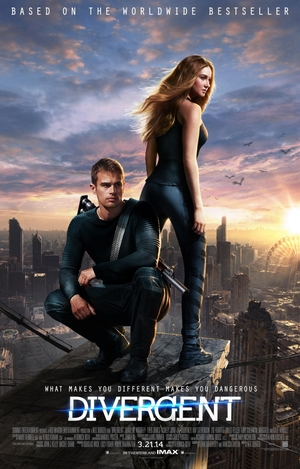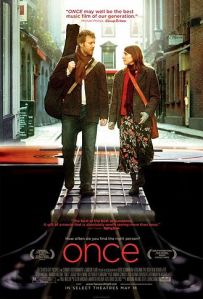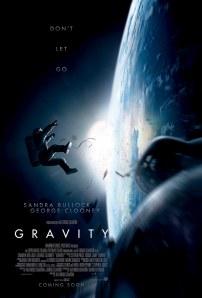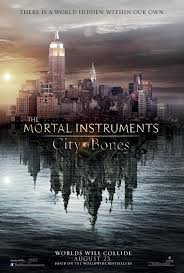 So who’s seen Catching Fire? If you’ve read the book, how does the movie hold up? How does it compare to The Hunger Games (film and book)? Come on in and let’s talk!
So who’s seen Catching Fire? If you’ve read the book, how does the movie hold up? How does it compare to The Hunger Games (film and book)? Come on in and let’s talk!
Before I get into the spoilers, here’s a quick movie review: For me, the book dragged, especially in the first half, and the movie has tightened up the plot without dropping anything essential or feeling rushed. As with the first film, the addition of scenes showing President Snow and the new Gamemaker helps to explain some of what Katniss experiences – oddly enough, making the conflict feel even more immediate. Katniss does a bit too much weeping and screaming for my taste, but overall, Jennifer Lawrence does a stellar job again. Fabulous adaptation, wholeheartedly recommended.
(Note: I have not yet read Mockingjay, so I’m reacting to the film without knowing how the trilogy plays out. Please refrain from discussing Mockingjay in the comments, unless you mark your comment clearly as being a spoiler!)
Spoilers below…
What Got Cut
Because books are longer than movies, any film adaptation of a book has to cut something. The trick is deciding what can be cut while still creating a coherent story. Sometimes this results in an almost entirely different story, or else a film that rushes through without dwelling properly to give the audience the emotional journey they crave.
In this case, the film adaptation sticks very close to the plot of the book – even closer than the first film, which shows unrest in the districts even though in the books Katniss doesn’t learn about this until Catching Fire.
One major difference is that several events in the first half of the book are condensed or eliminated – her PTSD-induced nightmares where Peeta comes to comfort her are trimmed down to a single scene (two if you include the flashback while she’s hunting with Gale), her leg injury is skipped altogether, District 13 is barely mentioned, her personal grooming team is gone except for Cinna, and the idea of “talents” is also gone.
The elimination of Katniss’s supposed talent in design is no great loss, but cutting Peeta’s talent with art leads to a moment of confusion. When Katniss enters the training arena to show off her skills, it’s not clear that Peeta did the painting of Rue. That bit couldn’t be cut because it’s what incites Katniss to make the dummy of Seneca Crane, but if you hadn’t read the books, you’d be lost.
Other than that, trimming the first half works well – the montage of the Victory Tour hits all the highlights from the book and is still very effective. In fact, it is even clearer in the film that Katniss and Peeta’s attempts to stick to the Capitol-approved script only incited more discontent from their audience.
I didn’t notice much, if anything, missing from the film version once the Games started…did you?
What Got Added
As with The Hunger Games, the film version of Catching Fire adds the point of view of President Snow, letting us see more about his motivation and his interactions with the Gamemaker. (Though, critically, we are not privy to the motivations of Plutarch Heavensbee until the end.) This fills in some of the pieces that, to me, were missing in the book.
 For example, when I read the book, I had a hard time buying that Katniss’s love life was really so important to President Snow. But with the movie, seeing Snow and Heavensbee talk about Katniss in her absence, Snow’s thought process is clearer.
For example, when I read the book, I had a hard time buying that Katniss’s love life was really so important to President Snow. But with the movie, seeing Snow and Heavensbee talk about Katniss in her absence, Snow’s thought process is clearer.
She really has become a symbol of resistance, and if he kills her outright she’ll be a martyr, but he has to bring her in line somehow. The increased Peacekeeper presence, for example, is a direct reaction to the threat she poses. It’s meant to cow and deter, not only District 12 as a whole, but also Katniss specifically.
It’s also chilling to watch Snow and Heavensbee plot Katniss’s downfall. Everything she tries is met with a counter-move. It reminds me of that XKCD comic about the definition of success. First of all, she contemplates running away. Then she realizes she can’t run, but she only has to get through the Victory Tour and pretend to be madly in love with Peeta until the tour is over. Then Haymitch explains that that’s not enough, they’ll have to pretend for the rest of their lives. And then Snow drops the bombshell: she’s going back into the Games.
Now that’s good plotting. All of Snow’s counter-moves are in the book, of course, but they’re explicitly shown in the film, and that change makes the tug-of-war between Katniss and Snow more gripping.
The Characters
Jennifer Lawrence did a brilliant job as Katniss in the first movie, and if anything, she’s even better here. Everything from her PTSD to her grief for Rue feels real, and the final close-up on her face would not have been nearly as effective with a lesser actress.
My only quibble is that she’s continually bursting into tears. Fewer tears would have made the remaining ones more effective. If I were directing, I would have had her cry when she learns she’s going back into the Games, when she and Finnick are trapped with the jabberjays, and maybe one other time, but that’s all.
As before, the acting for the secondary characters is fabulous. Most of them, particularly the adults, are a little flat, but at the same time they’re distinctive. Look at any line Effie or Haymitch delivers, and there’s no way that line could belong to anyone else. I even caught myself muttering “Oh, Effie” in fond exasperation at some points.
The new additions are also strong, and come across very much as they’re portrayed in the book. The other tributes are broken people, and it shows. I particularly liked Philip Seymour Hoffman’s Plutarch Heavensbee, who presents as a complete opposite to his predecessor, the foppish Seneca Crane.
A Few Notes on the Story
I also want to mention a few things about Catching Fire that aren’t specifically about book vs. movie.
My movie-going companion maintains that Katniss is weaker in Catching Fire than in The Hunger Games because she spends a lot of time dwelling on the love triangle. By contrast, I feel – especially with the book – that it’s Peeta and Gale who are dwelling and pining away, while Katniss stands aloof from both of them. What’s your take?
(Speaking of “weak”, here is a great point about Peeta and his masculinity.)
I mentioned earlier that I had trouble suspending my disbelief when President Snow takes such a close interest in Katniss’s love life. The other major plot point I had trouble buying was that so many of the other tributes would join in on the plan to keep Katniss alive, when it’s at the expense of their own lives. Of course, maybe I’m still underestimating the extent to which she’s become a symbol for everyone outside the Capitol, or maybe this is explained further in Mockingjay.
Your turn! What did you think of Catching Fire?
 If you’ve listened to all the buzz surrounding Black Panther, you’ll know that Afrofuturism* is having a moment. Black Panther is the Big Hollywood Blockbuster version of an Afrofuturist film. If you want to see the small indie version, look for Brown Girl Begins.
If you’ve listened to all the buzz surrounding Black Panther, you’ll know that Afrofuturism* is having a moment. Black Panther is the Big Hollywood Blockbuster version of an Afrofuturist film. If you want to see the small indie version, look for Brown Girl Begins. Lewis describes the film as a prequel. If you’ve read the book, be prepared–although the backstory and character relationships are drawn from the book, the plot is quite different. So is the geography, which will be slightly confusing to both readers of the book and Torontonian viewers. Though it is pretty neat–and a bit mindboggling–to see Toronto depicted as an untouchable nirvana, the harbour as (once again) a polluted cesspit, and the Toronto Islands as a place of exile and poverty.
Lewis describes the film as a prequel. If you’ve read the book, be prepared–although the backstory and character relationships are drawn from the book, the plot is quite different. So is the geography, which will be slightly confusing to both readers of the book and Torontonian viewers. Though it is pretty neat–and a bit mindboggling–to see Toronto depicted as an untouchable nirvana, the harbour as (once again) a polluted cesspit, and the Toronto Islands as a place of exile and poverty.
 This weekend I saw two films about the performance of masculinity, coming-of-age stories about struggling with machismo, as well as surrogate fatherhood and flawed role models.
This weekend I saw two films about the performance of masculinity, coming-of-age stories about struggling with machismo, as well as surrogate fatherhood and flawed role models.
 Second, my flash fiction piece “Urban Renewal” has been accepted to an upcoming anthology published by
Second, my flash fiction piece “Urban Renewal” has been accepted to an upcoming anthology published by 









